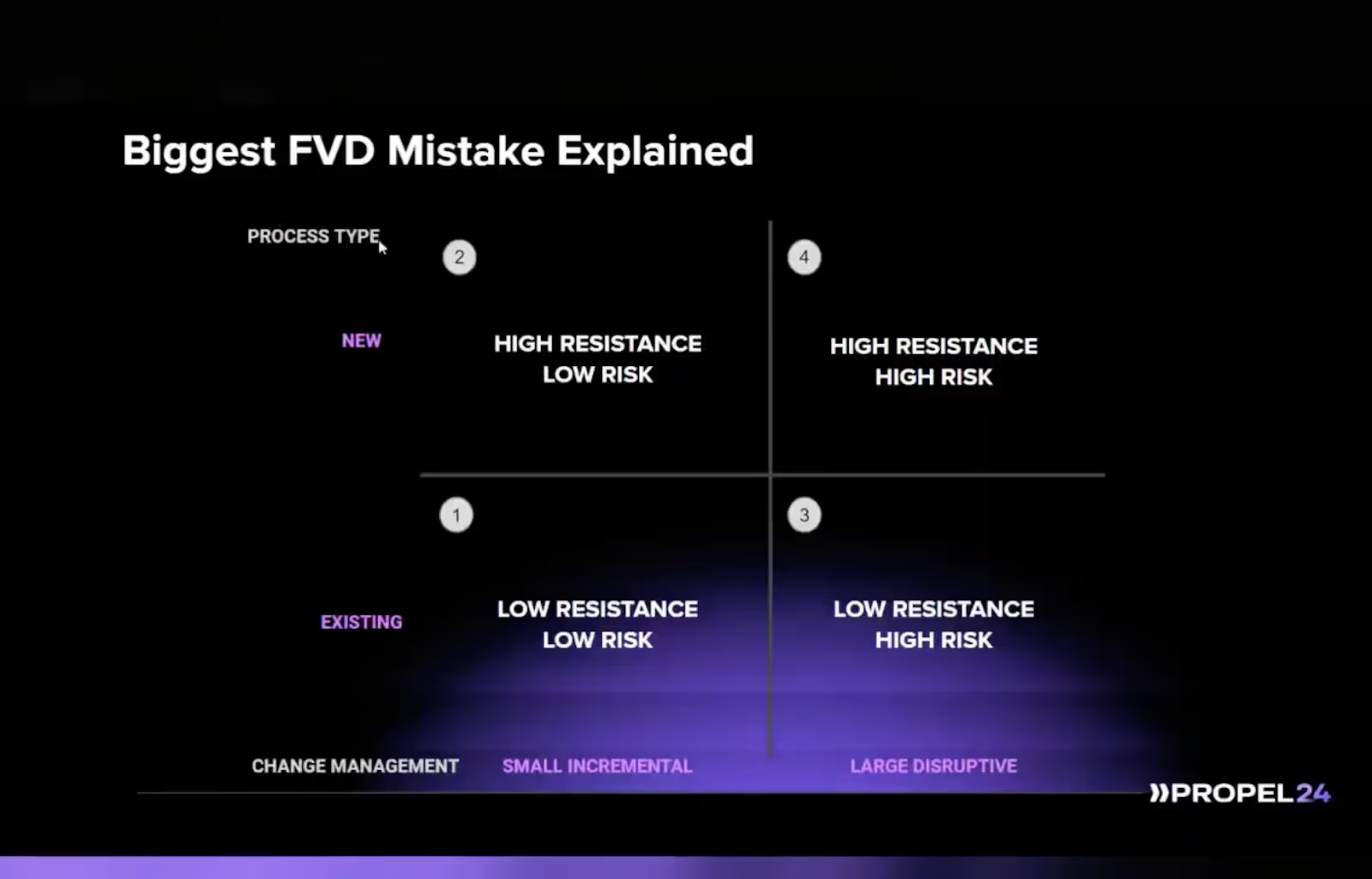Reaching the first value delivered (FVD) can feel a lot like navigating an obstacle course.
Just as an obstacle course is filled with various challenges to overcome before crossing the finish line, achieving FVD involves tackling numerous difficulties that can hinder progress. In many organizations, teams face several hurdles that delay or complicate delivering initial value, such as customers who are slow to respond or not fully engaged despite clear communication.
So, why is this happening?
During her session at Propel24, Irit Eizips, Chief Customer Officer and CEO of the CSM practice, shed light on three common mistakes teams often make during onboarding and implementation and provided tips on how to steer clear of them. She also highlighted key principles for crafting unforgettable "wow" moments in your customer journey.
Here are the major highlights and takeaways from the session.
The 3 common data mistakes to avoid during onboarding and implementation
Here are the 3 common mistakes that are typically made during first value delivery and go live.
Mistake #1 - Not all FVDs are made equal
Sometimes, after delivering an FVD, you might not see any immediate results. But other times, your efforts will make a big splash! Clients will embrace change management, and it will be a cause for celebration.
But, we do need to instill some guidelines on how much influence clients should have in deciding on the first value delivered.
Guidelines for selecting the first value delivered
When selecting what value customers should focus on or understanding what will work for them, these two crucial factors need to be considered:
- Process impact
Determine what type of process you aim to influence. Is it an existing process or a brand-new one? This distinction will guide your approach and strategy. - Implementation effort
Assess the level of effort required to implement the change. Will it be easy and involve small incremental steps, or will it be a significant, disruptive change that demands extensive resources, data cleansing, and overcoming numerous barriers?
By considering these aspects, you can provide clearer guidance and better align with the customer's needs and capabilities.
Recommended actions
- Whenever possible, avoid implementing new processes.
- If your system has something that improves existing processes without requiring significant changes, break it down into smaller tasks.
Approach for quick wins
Initially, focus on delivering value through our existing processes. However, if the current method doesn’t yield the desired results and you have a new process that seems simpler, feel free to give that a try.
Handling change resistance
The human mind often struggles with new changes, facing increased resistance. When it comes to established processes, there's less to learn, making them easier to manage.
Gradual implementation
Implement changes one step at a time, like moving from manual to automated processes, to reassure the customer that you won't overhaul everything at once and show them how improvements are being made gradually.
Risk management
If the implementation involves more risk, phasing out the adoption is advisable as it leads to a better first value delivered framework.
By following this approach, we can achieve quick wins more efficiently and ensure a smoother transition for our clients.

Mistake #2 - FVD is not enough!
Simply tracking FVD doesn't guarantee that it will be used effectively. Even if we choose the correct initial value, issues can still arise. Plus, we can't forget about the "wow" moment – it's so important to measure how long it takes a customer to reach that point. Without tracking this critical metric, we're missing a big piece of the puzzle!
But why is this missing? In Customer Success (CS), there's a well-known formula released by Gainsight:
CS = CX * CO
(Customer Success = Customer Experience and Customer Outcome)
Providing a great experience is absolutely essential; simply delivering an outcome just won’t cut it. That’s why focusing on FVD alone isn’t enough.
Take it a step further with:
FVD + Time to Wow (TTW) to create an "AHA" moment
But wait, what exactly is "Time to Wow"?
It's exactly what it sounds like, creating a "wow" moment where the customer is genuinely impressed and excited. Imagine you're on a call with a customer, and they suddenly exclaim, "Wow, that's awesome!" That's the reaction you're aiming for.

The goal is to leave your customer excited and impressed, eventually leading to that “AHA” moment.
Mistake #3 - What's the plan?
Now, FVD and wow moments have been identified, but what’s the plan? What journey has been planned for these special moments?
Not having these plans or tracking how long they take is one of the biggest mistakes you can make during the onboarding phase, leading to churn and a poor experience. Define a journey not just for FVD but also for those wow moments.
3 Hot principles to help your team design "wow" moments in the customer journey
1. Start by creating the initial design for the WOW project. Once that's completed, you can move on to developing the second, the FVD. Prioritizing them in this order ensures that each project gets the attention and detail it deserves.
First Wow
Delivered in Week 1, this is the initial experience that sets the stage. It’s the first major impression and should truly stand out.
This even includes surprising them with some delicious cookies.

Second wow
In Week 2, focus on delivering early value. This doesn’t necessarily mean going live with the full product or service but rather showcasing quick wins and introducing more efficient ways to handle current processes. Offer advice on best practices and guide them through a maturity model. This is the phase where you start becoming a trusted advisor.
Third wow
By Week 3, aim to deliver what we call the FVD. When done correctly, even this can be another "wow" moment, solidifying your role as a reliable and impactful partner.

2. The second principle is about creating a comprehensive list of valuable first actions to deliver.
Here's how to make it effective:
- Identify the value to be delivered and classify it as easy or difficult.
- Determine whether this value is based on an existing process or something new.
- Prepare a detailed talking track for Customer Success Managers (CSMs) and important managers to follow.
- Plan for a multiphase implementation to ensure smooth execution.
3. The third principle is about tracking FVD and Design Wow Moments
It's essential to monitor both First Value Delivered and unforgettable "wow" moments in your design. These are key indicators of successful interactions with your customers.
Additionally, consider this third aspect: Is the customer willing to advocate for your product at the end of the onboarding process, particularly during the go-live moment? This is a strong piece of evidence showing that you've successfully delivered at least three wow moments and one FVD.
{{demo}}



















